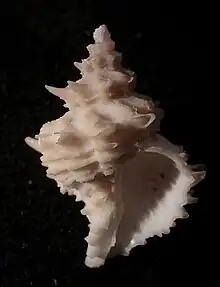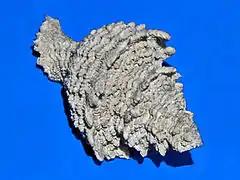| Babelomurex cariniferus | |
|---|---|
 | |
| Apertural view of Babelomurex cariniferus | |
| Scientific classification | |
| Domain: | Eukaryota |
| Kingdom: | Animalia |
| Phylum: | Mollusca |
| Class: | Gastropoda |
| Subclass: | Caenogastropoda |
| Order: | Neogastropoda |
| Family: | Muricidae |
| Genus: | Babelomurex |
| Species: | B. cariniferus |
| Binomial name | |
| Babelomurex cariniferus (Sowerby I, 1834) | |
| Synonyms[2] | |
| |
Babelomurex cariniferus, common name Babel's latiaxis, is a species of sea snail, a marine gastropod mollusc in the family Muricidae, the murex snails or rock snails.[2][3]
Distribution
Babelomurex cariniferus is present from the Mediterranean Sea to the west coast of Africa (Canaries, Cape Verde, Angola).[2][4][5][6]
This species (as junior synonym Latiaxis babelis) is listed in the IUCN Red List, because it is thought to be endemic to Malta.[1]
Habitat
These sea snails live in the coral reef among corals and sponges. They can be found from a few meters to more than 1000.[2][7]

Description
Shells of Babelomurex cariniferus can reach a size of 20–45 millimetres (0.79–1.77 in).[5] The shell surface may be whitish or dark greyish.[8] These shells are variably shaped. They show numerous flattened spires with very thorny axial ribs. The keels of the whorls are adorned with several spiniform scales. A corneous operculum is present.[7][9]
This species is quite similar to Babelomurex benoiti, but Babelomurex cariniferus is more variable in feature and sculpture and differs in the number of spiniform scales.[10]
Biology
These uncommon infralittoral sea snails are specialist feeders. In fact they feed exclusively on the polyps of the colonies of scleractinian stony corals.[7][11]
References
- 1 2 Palazzi, S. (1996). "Latiaxis babelis". IUCN Red List of Threatened Species. 1996: e.T11368A3273689. doi:10.2305/IUCN.UK.1996.RLTS.T11368A3273689.en.
- 1 2 3 4 Babelomurex cariniferus (Sowerby, 1834). Retrieved through: World Register of Marine Species on 24 April 2010.
- ↑ Biolib
- ↑ Galli C.: WMSDB - Worldwide Mollusc Species Data Base
- 1 2 "Babelomurex (Babelomurex) cariniferus". Gastropods.com. Retrieved 12 January 2019.
- ↑ Discover Life
- 1 2 3 "Ginux.univpm". Archived from the original on 16 June 2014. Retrieved 20 December 2015.
- ↑ Giovanni Nikiforos (2002). Fauna del Mediterraneo. Giunti Editore. p. 184. ISBN 978-88-09-02608-7.
- ↑ Conchiglie del Mediterraneo
- ↑ Ghisotti, F., 1978: Considerations on Latiaxis babelis and on Latiaxis amaliae Conchiglie (Milan) 14(7-8): 135-142
- ↑ Alexandra Richter and Angel A. Luque Sex change in two Mediterranean species of Coralliophilidae (Mollusca: Gastropoda: Neogastropoda)
External links
- NCBI
- "Babelomurex (Babelomurex) cariniferus". Gastropods.com. Retrieved 15 January 2019.
Bibliography
- Cossignani T. (2010) Validazione di Babelomurex tectumsinensis (Deshayes, 1856). Malacologia Mostra Mondiale 66: 19
- Emilio Rolan - Malacological Fauna from the Cape Verde Archipelago
- Gofas, S.; Afonso, J.P.; Brandào, M. (Ed.). (S.a.). Conchas e Moluscos de Angola = Coquillages et Mollusques d'Angola. [Shells and molluscs of Angola]. Universidade Agostinho / Elf Aquitaine Angola: Angola. 140 pp.
- Gofas, S.; Le Renard, J.; Bouchet, P. (2001). Mollusca, in: Costello, M.J. et al. (Ed.) (2001). European register of marine species: a check-list of the marine species in Europe and a bibliography of guides to their identification. Collection Patrimoines Naturels, 50: pp. 180–213
- Repetto G., Orlando F. & Arduino G. (2005): Conchiglie del Mediterraneo, Amici del Museo "Federico Eusebio", Alba, Italy
